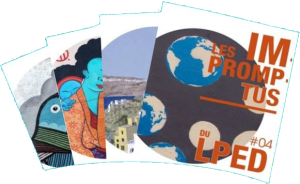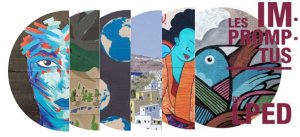L’émergence de la culture du figuier de Barbarie en zone pré-saharienne marocaine
L’émergence de la culture du figuier de Barbarie en zone pré-saharienne marocaine
Sous-titre
(Région de Sbouya-Sidi Ifni) Incidences paysagères et socio-territoriales
Auteur.e.s
NumerosImpromptus
- #05
Résumé
Si le figuier de Barbarie (« aknari ») fait l’objet d’une culture ancienne dans la région de Sidi Ifni, zone côtière aride du sud marocain reconnue pour ses fruits particulièrement juteux, elle a pris un essor considérable à partir de la fin des années 70, du fait – étonnamment – de la forte émigration de la population locale qui a vu dans cette culture ne nécessitant que peu d’entretien, un moyen d’affirmation foncière. Depuis les années 2000, différents produits issus du figuier de Barbarie (confiture, miel, infusion, huile de pépins) participent à la mise en dynamique d’une filière active. L’objectif de cet article est d’analyser comment l’émergence de spécificités locales du sud marocain peut permettre d’élargir la perspective sur des formes originales de gestion des milieux en zone aride, et ce à différents niveaux :
- Au niveau paysager, avec une emprise très forte la culture du figuier de Barbarie et des remontées biologiques sous-jacentes, et notamment la réapparition de l’arganier pouvant conduire, à terme, à l’établissement de parcs agroforestiers productifs très prometteurs
-Au niveau des systèmes de production, tout à fait originaux, basés sur la non présence à l’année des agriculteurs
- Au niveau des produits avec une diversification et des recherches de marchés non encore stabilisés
- Au niveau des dynamiques socio-territoriales et des enjeux qui y sont liés (installation d’usines de transformation, mise en place de réseaux et d’une filière).
Ces dynamiques sont porteuses à la fois d’incertitudes quant aux niveaux de pression exercé sur le milieu, aux différenciations socioéconomiques en cours et à la gouvernance de la filière en cours de formation, et de potentialités dans un cadre élargi associant activités économiques et lutte contre la désertification.
- Au niveau paysager, avec une emprise très forte la culture du figuier de Barbarie et des remontées biologiques sous-jacentes, et notamment la réapparition de l’arganier pouvant conduire, à terme, à l’établissement de parcs agroforestiers productifs très prometteurs
-Au niveau des systèmes de production, tout à fait originaux, basés sur la non présence à l’année des agriculteurs
- Au niveau des produits avec une diversification et des recherches de marchés non encore stabilisés
- Au niveau des dynamiques socio-territoriales et des enjeux qui y sont liés (installation d’usines de transformation, mise en place de réseaux et d’une filière).
Ces dynamiques sont porteuses à la fois d’incertitudes quant aux niveaux de pression exercé sur le milieu, aux différenciations socioéconomiques en cours et à la gouvernance de la filière en cours de formation, et de potentialités dans un cadre élargi associant activités économiques et lutte contre la désertification.
Abstract
Prickly pear («aknari») has been cultivated for centuries in the region of Sidi Ifni, an arid coastal area of southern Morocco known for its particularly juicy prickly pear fruits. However, its cultivation has expanded considerably since the late 1970s, due - surprisingly - to the strong emigration of the local population who saw in this culture requiring little maintenance, a means of land affirmation. Since the 2000s, various products from the prickly pear (jam, honey, infusion, seed oil) have emerged and participated to the development of an active industry. The objective of this article is to analyze how the emergence of local specificities of southern Morocco such as prickly pear cultivation, can broaden the perspective on original forms of environmental management in arid zones, at different levels:
- At the landscape level, with a very strong influence on the cultivation of prickly pear and the underlying biological upwelling, particular with the reappearance of the argan tree, which could eventually lead to the establishment of very promising productive agroforestry parks
- In terms of production systems, which are completely original, based on the fact that
farmers are not present all year round
- At the product level with diversification and a market not yet stabilized
- In terms of socio-territorial dynamics and related challenges (installation of processing plants from outside, establishment of networks and a sector)
These dynamics bring both uncertainties regarding the levels of pressure exerted on the environment, the socio-economic differentiations under way and the governance of the sector undergoing training, and potentialities within a broader framework combining economic activities and the fight against desertification.
- At the landscape level, with a very strong influence on the cultivation of prickly pear and the underlying biological upwelling, particular with the reappearance of the argan tree, which could eventually lead to the establishment of very promising productive agroforestry parks
- In terms of production systems, which are completely original, based on the fact that
farmers are not present all year round
- At the product level with diversification and a market not yet stabilized
- In terms of socio-territorial dynamics and related challenges (installation of processing plants from outside, establishment of networks and a sector)
These dynamics bring both uncertainties regarding the levels of pressure exerted on the environment, the socio-economic differentiations under way and the governance of the sector undergoing training, and potentialities within a broader framework combining economic activities and the fight against desertification.
Année de publication
2019
Discipline
- Géographie
- Ecologie
Fichier : LemergenceDeLaCultureDuFiguierDeBarbari_file_1607696204078_impromptus-5-4-r.pdf
Télécharger

